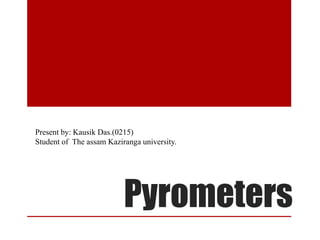Phyrometers
- 1. Present by: Kausik Das.(0215) Student of The assam Kaziranga university. Pyrometers
- 2. ÔÇß ÔÇß ÔÇß ÔÇß ÔÇß ÔÇß ÔÇß ÔÇß ÔÇß ÔÇß ÔÇß ÔÇß Transducers Classification of Transducers Application Advantages & Disadvantages Errors Temperature and Heat Pyrometer Principle Types Advantages and disadvantages Application Conclusion Contents
- 3. • Transducers is a device which convert mechanical force into electrical energy. We can also define transducers as device which transform energy from one form to another.  Example Photo conductor which converts light intensity into a change of resistance.  Thermocouple which converts heat energy into electrical energy. Transducers
- 4. Transducers can be classifiedÔÉò Primary and secondary ÔÉò Active and Passive ÔÉò Analog and Digital ÔÉò Inverse Transducers Classification of transducers
- 5. ÔÇß Primary Transducer: The Mechanical device which converts physical quantity to be measured into a mechanical signal. Secondary Transducer: The Electrical device which converts this mechanical signal to the electrical signal. ÔÇß Analog Transducer: These Transducers convert input quantity to an analog output which is continuous function of time. Ex-Thermocouple or Thermistor which gives analog output. Digital Transducers- These converts the input quantity into an electrical output which is in the form of pulses. ÔÇß Passive Transducers: These transducers which require an auxiliary power source to produce their output. Hence they are also known as externally power transducers. Ex-Resistive, Capacitive, Inductive. Active Transducers: These transducers which do not require an auxiliary power source to produce their output. Ex- Thermocouple, photo voltaic cells, etc ÔÇß Inverse Transducers: These transducers converts an electrical quantity into a non-electrical quantity. Ex-Piezo electric crystal.
- 6. • Antenna – converts propagating electromagnetic waves to and from conducted electrical signals. • Loudspeaker, earphone – converts electrical signals into sound (amplified signal → magnetic field → motion → air pressure) Application
- 7. • Hydrophone – converts changes in water pressure into an electrical signal. • Microphone – converts sound into an electrical signal (air pressure → motion of conductor/coil → magnetic field → electrical signal)
- 8. Low Current consumption. Operates in extremely cold temperature. Power requirement is very low for controlling the electrical or electronic system. Advantages & Disadvantages
- 9.  The mass inertia effect are minimized.  Effect of friction are minimized.  Electrical and electronic system is easily controlled with a very small power level.  The electrical output can easily be used, transmitted, processed for the purpose of measurement. Advantages of Electrical Transducers
- 10. • Scale Error •Dynamic error •Error due to Noise and Drift Errors in transducers
- 11. • A Temperature is a numerical measure of hot or cold. Its measurement is by detection of heat radiation or particle velocity or kinetic energy, or by the bulk behavior of a thermometric material. Temperature
- 12. Heat Temperature Definition: Heat is energy that is transferred from one body to another as the result of a difference in temperature. Temperature is a measure of hotness or coldness expressed in terms of any of several arbitrary scales like Celsius and Fahrenheit. Symbol Q T Unit Joules Kelvin, Celsius or Fahrenheit SI unit: Joule Kelvin Particles: Heat is a measure of how many atoms there are in a substance multiplied by how much energy each atom possesses. Temperature is related to how fast the atoms within a substance are moving. Ability to do work: Heat has the ability to do Temperature can only be work. used to measure the degree of heat. Temperature Vs Heat
- 13. Resistance Thermometer Thermistor Thermocouple and thermopile Transducers for measuring temperature
- 14. Pyrometer A pyrometer is a type of thermometer used to measure high temperatures. It is used for measuring temperature without any physical contact. Its is used for measuring body temperature by measuring its electromagnetic radiation.
- 15. • Its principle depends upon the relationship between temperature of a hot body and electromagnetic radiation emitted by the body. When a body is heated it emits thermal energy known as heat radiation. It is a technique for determining a body temperature by measuring its electromagnetic radiation. Principle of Pyrometer
- 16. • It is used for high temperature measurement. At high temperature other transducers such as thermometer may melt due to direct physical contact but pyrometer can be used for high temperature measurement without any physical contact. Pyrometer Vs other temperature transducers
- 17. ÔÉòRadiation Pyrometer ÔÉòOptical Pyrometer Types of pyrometer
- 20. • It can measure very high temperatures as no contact is required. • They have high output and moderate cost. • They possess fast response speed. • It has a good accuracy. • It is light in weight. Advantages of Pyrometer
- 21. • It requires direct line of sight to the object (or furnace) which the temperature is to be measured • It is subjected to emissivity error • The scale is non-linear • It is expensive Disadvantages of Pyrometer
- 22. • They can measure temperature above the range of thermocouple. • They can be use in the environment where the use of thermocouple is limited. • They are used for the target which would be damaged any contact with primary elements like thermocouples. • They are used for measurement of Average temperature of large surface area. Applications of Pyrometer
- 23. If you have any doubt regarding this slide just inform me. I love to solve it…….thank you.
Editor's Notes
- #11: Scale: 1. Zero Error: The difference in value between the theoretical and practical calculation in the curve is the zero error. 2.Sensitivity error: these error occurs when the output deviates from correct value by content value.Dynamic: Occur only when input quantity is varying with time.Error due to noise and drift: Both vary with time, in case of noise- consist of random amplitude and random frequency but drift: is slow change with time.Both are independent of input signal.
























